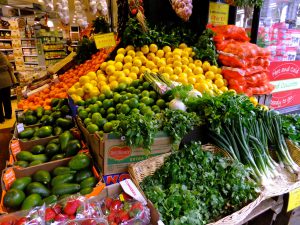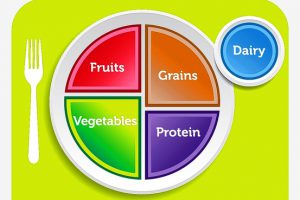Healthful eating begins…

Healthful eating begins with food you put in your shopping cart. Sounds simple, but with thousands of food items available in the supermarket, and new products coming almost daily, it can be a real challenge to choose the healthiest foods. Make grocery shopping easy with this food selection guide. When purchasing produce, make local farmers’ markets your first stop for the freshest assortment.
Fruit and Vegetable Groups
- Select fresh produce in season as it is usually less expensive and at peak flavor.
- Choose an assortment of produce to benefit from the different vitamins, minerals, fiber, and water they provide.
- When possible, it is better to eat your fruit than drink it for the benefits dietary fiber provides.
- For added convenience, consider pre-cut packages of fruit with no added sugar.
- When fresh is not available, purchase fruit that is dried, frozen, or canned with no added sugar. Canned fruits should be packed in water or 100% juice.
- Consider pre-cut, washed fresh vegetables. They are convenient for making salads and vegetable dishes with little to no waste.
- Frozen vegetables are quick and easy to prepare. Check the ingredient list and avoid products with added fat, salt, and sugar.
Grain Group
- Choose whole grains most often to get the nutritional benefit of the entire kernel – endosperm, germ, and bran.
- Examples of whole grains include whole wheat, bulgur, oatmeal, whole cornmeal, and brown rice.
- Click here to visit the Oldways Whole Grains Council website for more information on whole grains.
- Common food products include bread, bagels, crackers, rice, cereal, pasta, tortillas, and flatbreads.
Protein Group
- Protein foods come from animals and plants. Animal foods include meat, poultry, seafood, and eggs. Plant foods include legumes (beans, peas, and lentils), soy products, nuts, and seeds.
- Choose lean meat most often. Check the food label for fat content.
- Choose skinless poultry parts or remove the skin prior to cooking. For whole poultry, remove the skin after cooking. White breast meat is lower in fat than dark meat parts such as thighs, drumsticks, and wings.
- Heart-healthy seafood rich in omega-3 fatty acids include salmon, lake trout, sardines, mackerel, and albacore tuna.
Dairy Group
- – Milk and foods made from milk, such as yogurt and cheese, that contain calcium comparable to milk are part of this food group. However, milk products that contain very little or no calcium such as butter and cream are considered solid fats.
- Calcium-fortified soymilk (soy beverage) is also part of the dairy group.
- Healthiest choices are fat-free and low-fat.
Click here to visit the USDA Choose MyPlate website for information on healthful food choices, meal planning, and more.

Click here to visit the USDA Nutrient Database for nutrition information on food from all the groups.
 1
1
